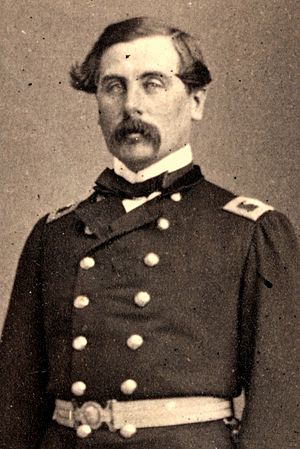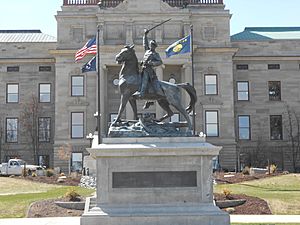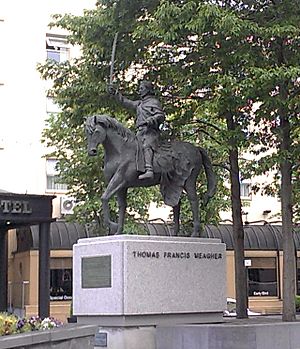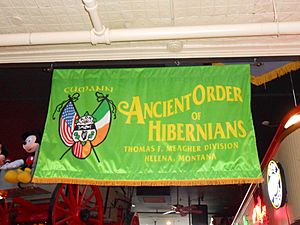Thomas Francis Meagher facts for kids
Quick facts for kids
Thomas Francis Meagher
|
|
|---|---|

Thomas Francis Meagher (1860s) in his formal military uniform
|
|
| Territorial Secretary of Montana Acting Territorial Governor of Montana |
|
| In office September 1865 – 3 October 1866 |
|
| Preceded by | Sidney Edgerton |
| Succeeded by | Green Clay Smith |
| In office December 1866 – 1 July 1867 |
|
| Preceded by | Green Clay Smith |
| Succeeded by | Green Clay Smith |
| Personal details | |
| Born | 3 August 1823 Waterford, County Waterford, Ireland |
| Died | 1 July 1867 (aged 43) Missouri River, Montana Territory |
| Political party | Irish Confederation (Ireland) Democratic (U.S.) |
| Spouses | Catherine Bennett (1851–1854; her death) Elizabeth Townsend (1856–1867; his death) |
| Children | 2 |
| Nickname | Meagher of the Sword O'Meagher (Temporally self given) |
| Military service | |
| Allegiance | Young Ireland Irish Confederation United States |
| Branch/service | United States Army |
| Years of service | 1848 (Young Irelanders) 1861–1865 (USA) Union Army |
| Rank | |
| Commands | Company K, 69th New York Militia; Irish Brigade |
| Battles/wars | Young Irelander Rebellion of 1848 |
Thomas Francis Meagher (3 August 1823 – 1 July 1867) was an important Irish nationalist leader. He was part of the Young Irelander movement and the Rebellion of 1848. After being found guilty of trying to overthrow the government, he was sent to Van Diemen's Land (now Tasmania) in Australia.
In 1852, Meagher escaped and made his way to the United States. He settled in New York City, where he studied law and worked as a journalist. He also gave talks about the cause of Irish freedom.
He later joined the U.S. Army at the start of the American Civil War. He became a brigadier general. He was famous for forming and leading the Irish Brigade. He encouraged many Irish immigrants to support the Union side.
After the Civil War, Meagher was made Montana's Territorial Secretary of State. He also served as the acting territorial governor. In 1867, Meagher drowned in the Missouri River after falling from a steamboat. Some people believe he may have been killed by political rivals in Montana.
Contents
Thomas Francis Meagher: Irish Hero and American General
Thomas Francis Meagher was born on 3 August 1823 in Waterford City, Ireland. His family lived in a house called Derrynane House.
His father, Thomas Meagher, was a wealthy merchant. He later became a politician and was elected Mayor of Waterford twice. He also represented Waterford in the British Parliament. His family had a long history of trade between Ireland and Newfoundland, Canada.
Thomas Francis Meagher's mother, Alicia Quan, died when he was only three years old. He had four siblings, but only he and his older sister Christine Mary lived to be adults.
Early Life and Learning
Meagher went to Catholic boarding schools. When he was eleven, he went to Clongowes Wood College in Ireland. There, he became very good at public speaking. He was the youngest person to win a medal in the school's Debating Society. These skills helped him become a leader in Irish nationalism later on.
After six years, Meagher went to Stonyhurst College in England. His father did not want him to go to Trinity College in Ireland. This was because it was seen as anti-Irish and anti-Catholic.
Meagher became known for his strong speaking skills. He was a very popular speaker at Conciliation Hall. This was the meeting place for the Irish Repeal Association.
Fighting for Ireland's Freedom
Meagher returned to Ireland in 1843. He planned to become a lawyer. He soon joined the Repeal Association. This group wanted to end the Act of Union between Great Britain and Ireland. This Act meant Ireland was directly ruled by Britain.
Meagher quickly became a popular speaker in Dublin. People would fill the hall to hear him talk. He and other young members of the movement were called "Young Irelanders." They believed Ireland should be fully independent.
The Young Irelanders disagreed with some older leaders. They did not want to make deals with British political parties. Meagher believed that Ireland's freedom should not be traded for political favors.
In July 1846, a debate happened about using force to gain freedom. Meagher gave his famous "Sword Speech." He argued that while peaceful means were best, there were times when fighting for freedom was necessary. He said he would choose arms if peaceful ways failed.
The Irish Flag
In January 1847, Meagher and other leaders formed a new group called the Irish Confederation. In 1848, Meagher visited France. He returned to Ireland with a new Irish flag. It was a tricolour of green, white, and orange. French women who supported Ireland's cause made and gave him this flag.
The green color stood for Catholics, and the orange for Protestants. The white in the middle meant a lasting peace between them. This flag was first shown in public in Waterford on 1 March 1848.
After a small uprising in August 1848, Meagher and others were arrested. They were found guilty of trying to overthrow the government. They were sentenced to death. However, because of public protests, their sentences were changed. They were sent to exile for life to "the other side of the world."
Life in Exile
In 1849, Meagher and his friends were sent to Van Diemen's Land (Tasmania). They were given "ticket-of-leave." This meant they had some freedom on the island. They promised not to escape without telling the authorities first.
Meagher married Catherine Bennett in Tasmania in 1851. Her father had been sent to Tasmania as a convict. Some of Meagher's friends did not approve of the marriage. But Meagher did not care.
In January 1852, Meagher decided to escape. He sent his "ticket-of-leave" back to the authorities. He said he would consider himself a free man in 24 hours. He then escaped to the United States. Catherine was pregnant and stayed behind. Their son, Henry, was born but died at four months old.
Catherine later traveled to Ireland and then to the United States to be with Meagher. She returned to Ireland and gave birth to another son, Thomas Bennett Meagher. She died soon after. Meagher never met his second son, who was raised by relatives in Ireland.
A New Life in America
Meagher arrived in New York City in May 1852. He studied law and journalism. He became a well-known speaker. He also became a United States citizen.
He started a newspaper called the Irish News. He and another escaped Irish leader, John Mitchel, published a newspaper called the Citizen. It supported Irish independence.
Before the Civil War, Meagher traveled to Costa Rica. He wanted to see if Central America would be a good place for Irish people to move. He wrote travel articles about his experiences.
Joining the Civil War
When the American Civil War began in 1861, Meagher decided to fight for the Union. He believed it was important for both America and Ireland. He started recruiting men for the Union Army.
He placed ads asking for "One hundred young Irishman." His recruits formed Company K of the 69th Infantry Regiment of the New York State Militia. This group was known as the "Fighting 69th." They fought in the First Battle of Bull Run.
After this battle, Meagher returned to New York. He formed the famous Irish Brigade. He encouraged Irish people in the North to join and defend the Union. He was made a brigadier general in 1862.
Leading the Irish Brigade
Meagher led the Irish Brigade in many battles. They fought bravely in the Peninsula Campaign. At the Battle of Fair Oaks, the Irish Brigade earned a reputation as fierce fighters.
They suffered huge losses at the Battle of Antietam in September 1862. Meagher's brigade lost 540 men in a fierce attack. He was injured when he fell off his horse.
The Irish Brigade had its biggest losses at the Battle of Fredericksburg. Meagher led 1,200 men into battle. The next morning, only 280 men were left. Meagher himself was not directly in the battle due to a knee injury.
Meagher resigned from the Army in May 1863. He had asked to go back to New York to get more men for his brigade, but the Army refused. His brigade had gone from 4,000 men to only a few hundred. Later, his resignation was canceled, and he served in other areas of the war. He left the Army for good in May 1865.
Governor in Montana
After the war, Meagher was appointed Secretary of the new Montana Territory. Soon after, he became the Acting Governor.
Montana was growing quickly because gold had been discovered there. Many new settlers arrived. They often ignored agreements with the local Native American tribes.
In 1867, a pioneer named John Bozeman was killed. Meagher organized a volunteer militia to fight against the Native Americans. He got money from the government for this. However, he could not find the attackers or keep the militia together. Some people criticized his actions.
Meagher also tried to create a constitution for Montana. This was a step toward Montana becoming a state. But not enough people voted for it. Montana finally became a state in 1889, many years after Meagher's death.
His Mysterious Disappearance
In the summer of 1867, Meagher traveled to Fort Benton, Montana. He was going to pick up guns and ammunition for the Montana Militia. He became ill on the way.
On 1 July 1867, Meagher fell overboard from a steamboat into the Missouri River. The river was deep and fast-moving. His body was never found.
Many people thought his death was suspicious. Some believed he was murdered by a former Confederate soldier or by Native Americans. In 2016, a writer named Timothy Egan suggested that Meagher might have been killed by his political enemies in Montana.
Meagher was survived by his second wife, Elizabeth. He was also survived by his second son, Thomas Bennett Meagher. This son was from his first marriage and lived in Ireland. Meagher never met him.
Remembering Thomas Francis Meagher
- The Thomas F. Meagher Foundation works to promote pride in the Irish flag.
- A statue of Meagher on horseback stands in front of the Montana State Capitol in Helena. It was put there in 1905.
- A similar statue honoring him was put up in 2004 in Waterford, Ireland. This is near his childhood home.
- In 1963, President Kennedy spoke about Meagher's legacy. He gave the battle flag of the Irish Brigade to the people of Ireland. It is now in Leinster House, where the Irish Parliament meets.
- Meagher County, Montana, is named after him.
- A monument to him is at the Battle of Antietam battlefield. It tells his life story.
- A memorial bust of Meagher is on the bank of the Missouri River in Fort Benton, Montana. This is near where he is believed to have fallen overboard.
- The Suir Bridge in Waterford, Ireland, was renamed the Thomas Francis Meagher Bridge in 2015.




